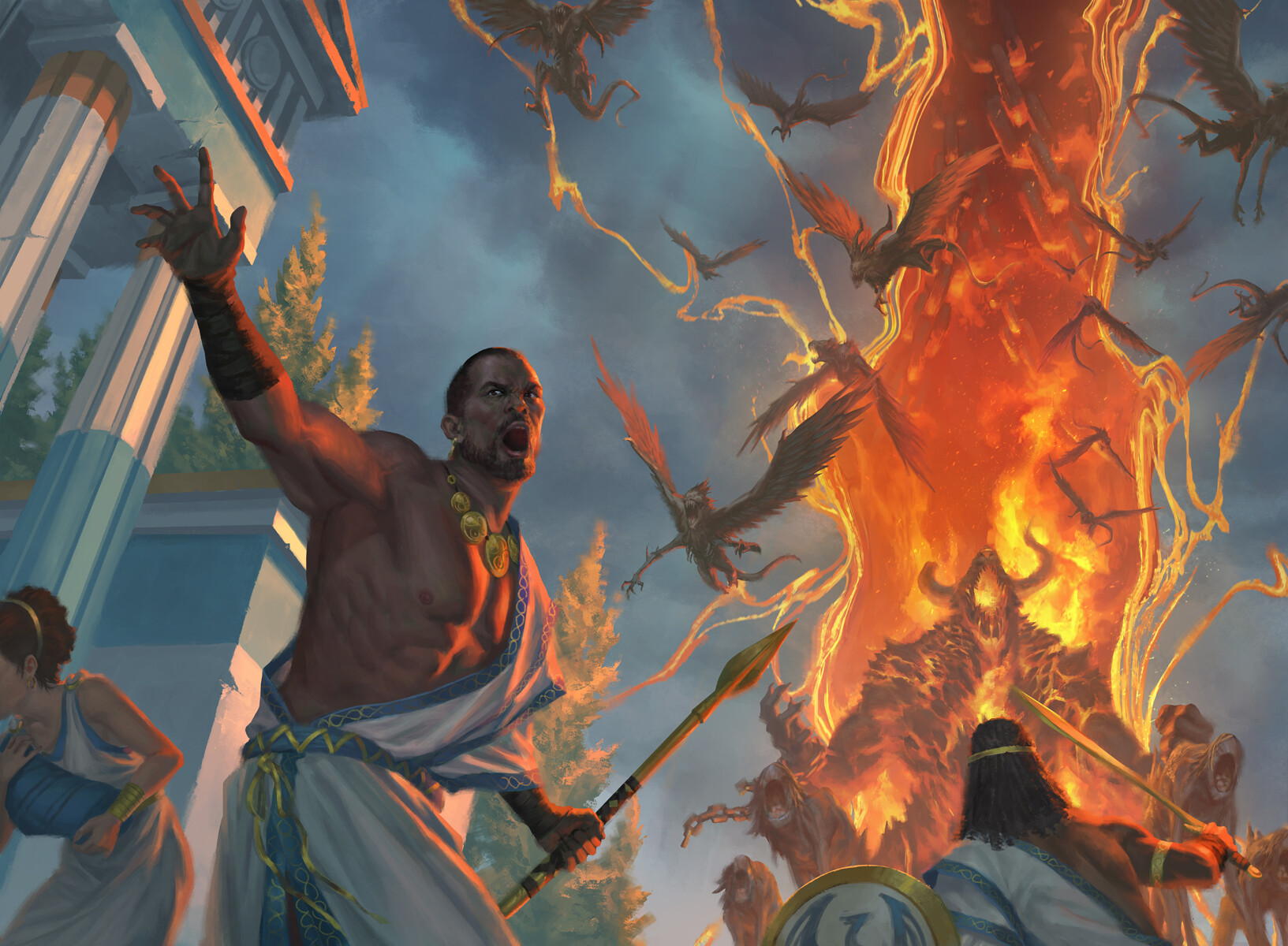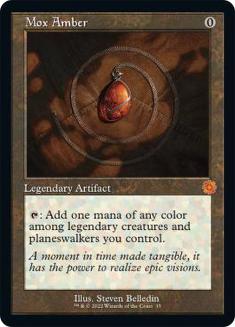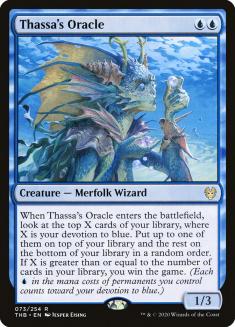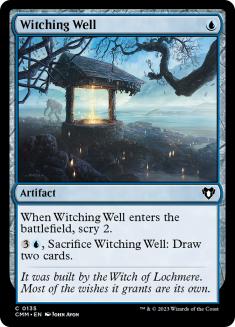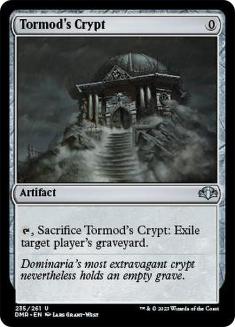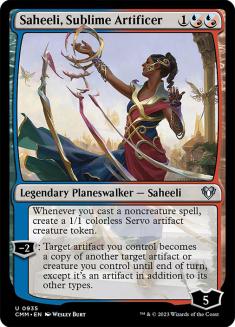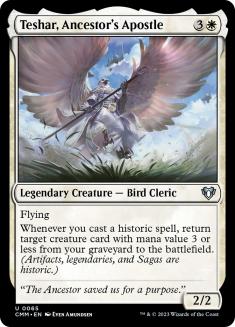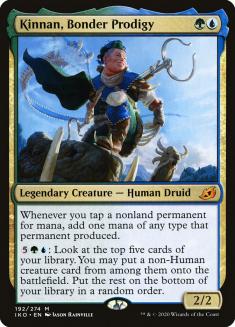I’ve been playing a lot of Historic over the weekend, following my article from last week and in preparation for the Arena Open this weekend. I’ve gravitated towards working on various Underworld Breach strategies, and today I’ll be sharing what my current front-runner is as well as some different ideas I’ve messed with.
What I’ll likely be playing this weekend:
Creatures (17)
- 1 Teshar, Ancestor's Apostle
- 4 Diligent Excavator
- 2 Fblthp, the Lost
- 4 Emry, Lurker of the Loch
- 2 Thassa's Oracle
- 4 Lurrus of the Dream-Den
Planeswalkers (6)
Lands (23)
Spells (14)

How the Deck Works
The end state of Jeskai Breach is to mill your entire library or near it and cast Thassa’s Oracle. Achieving this can happen in a few different ways, but the most common setup is to have to two Diligent Excavators and an Underworld Breach on the battlefield and repeatedly cast a zero-mana spell — in this case Mox Amber or Tormod’s Crypt — to net cards in graveyard and keep going, eventually finding two Mox Ambers which will generate the two mana need to cast the Oracle.
The key to the deck is there are very few hard and fast rules to achieve this setup. While you can goldfish extremely quickly, the amount of excess mana you have lying around, or a valuable permanent like Emry, Lurker of the Loch or Lurrus of the Dream-Den, can influence whether it’s worth it to “short storm” (to try to go off without a deterministic battlefield state).
An Underworld Breach and two copies of Emry might be able to dig you into exactly what you need to win, a Lurrus can cast a Diligent Excavator mid-combo, and just generating a battlefield with Underworld Breach can be enough of an advantage to be worth it — especially if you have a Lurrus to rebuy the Underworld Breach and go again on the following turn.
The point is, it’s hard to convey exactly all the angles that Jeskai Breach has – and I wouldn’t call myself an expert by any means after just a week of playing – but I do think I have enough knowledge to impart on what works and what falls flat and the type of innovations that might be on the horizon for Breach as a strategy in Modern.
The deck is fast, can be plenty resilient thanks to Lurrus and Emry, and has room to grow. That’s enough applicable terms to be a candidate for “best deck” in my eyes.
Card Choices
Here’s the core of the deck:
Creatures (11)
Planeswalkers (4)
Spells (7)

This is kind of the smart-ass version of this type of analysis — you might look at this as being way too minimalist for a combo deck, but I’m quite serious.
I even almost left off Teferi, Time Raveler, but assuming we’re playing Jeskai (and I’ll be touching on some versions that could theoretically eschew white), there isn’t any reason to not play four copies of the powerful planeswalker. Lurrus is similar. Teferi also just offers so many different types of tricks and interaction in this deck, from bouncing your own Mox to generate mana and Excavator triggers to being an anti-hate card against Grafdigger’s Cage, Leyline of the Void, and many others.
Mox Amber is the best card in the deck as it’s responsible for making you faster than other decks as well as enabling a bunch of tricks and being the core combo piece.
You don’t really “have to” play more than one copy of Thassa’s Oracle as a win condition, but playing two leaves you far less vulnerable to weird things happening like a random Ashiok activation or Scavenging Ooze leaving you in the much harder spot of having to mill your opponent out rather than a quick and easy kill.
Oracle is also passable as a deck manipulation spell, so it doesn’t bear as high an opportunity cost as most iconic win conditions in this vein, such as Laboratory Maniac.
Filling in the Rest
I played Chromatic Sphere for a long time over Witching Well to determine which is stronger, but Witching Well does a few things better (immediately digging a little bit deeper to hit land drops or find key pieces, staying on the battlefield without as much tension to make casting Emry earlier easier, and being a blue pip for Thassa’s Oracle). In heavy wars of attrition (and post-sideboard) Witching Well’s draw ability is also more impactful and rewards you more heavily for recurring it, even if it is a larger investment. For now, I think the Well is simply stronger in Jeskai Breach.
The purpose of Tormod’s Crypt is primarily to be another zero-mana spell to jump-start your combo if you haven’t found two Mox Amber. Most lists are playing Stonecoil Serpent. Stonecoil Serpent’s primary benefit is that it can be cast as a respectable blocker against aggro decks.
Tormod’s Crypt’s benefits far outweigh that:
- Just on its face it’s a strong card to incidentally have in your deck against the mirror; Kethis Combo; or Uro, Titan of Nature’s Wrath strategies.
- It’s a zero-mana spell that you can deploy onto the battlefield to reduce the cost of Emry. Stonecoil Serpent requires a mana investment, and there’s no guarantee you’ll be able to get it in your graveyard when desired to start comboing off with Breach.
- Finally, it’s a noncreature spell to trigger Saheeli, Sublime Artificer.
The card whose inclusion I go back and forth with the most. Saheeli does a ton of things; it just doesn’t do any of them particularly well.
Best-case scenario, Saheeli acts as a proxy for Diligent Excavator #2, letting you copy it and combo kill your opponent in a situation you otherwise couldn’t win.
Saheeli also allows you to copy (and thus kill) any of your legendary creatures and artifacts — Mox Amber, Emry, and Lurrus — to essentially get another activation out of them.
Finally, she can serve as an alternate win condition in tough pinches or simply provide enough pressure to take down opposing planeswalkers or buy you time through chump blockers.
Again, most of what Saheeli does isn’t particularly high-impact but she can cover a lot of different angles, and as a result I haven’t found a better use for her slots.
The Tangent Portion of the Article
On its face, Teshar, Ancestor’s Apostle just looks like a powerful form of resiliency that can rebuy your creature pieces. What it should be able to do is also create another alternate combo with two Lurrus and two Mox where the Moxes rebuy the Lurrus, giving you a new opportunity to play a Mox, generate a mana, and so forth.
Now for the life of me, I can’t figure out how to get this work on Arena. I’ve even been mocked by Sparky for ten minutes trying to figure out how to ensure picking the correct Lurrus to make the combo work. A Google search found a Reddit thread that helped enforce my theory that this is a bug and I’m in fact, not crazy and/or an imbecile.
Regardless, this sucks, but Teshar can still do a lot for Jeskai Breach and is one of the absolute best follow-ups to a sweeper. For now, a worthy use of a slot.
Playing Four Copies of Lurrus
The primary advantage of Jeskai Breach over a deck like Kethis Combo is how powerful Lurrus is as a vital form of redundancy for letting you recast Diligent Excavator and your various artifacts, but most importantly it can also just outright start your combo by letting you cast Underworld Breach out of your graveyard.
Lurrus can kind of suck sometimes — it’s hard to cast and can be clunky, but it singlehandedly lets you play long games and slog through interaction. Similarly to some other notes, I can’t find better use for the slots even though I don’t view four copies as a sacred cow.
The Mana
I’ve slowly chopped more and more blue sources for white sources as I’ve bricked on Lurrus over the past week. There’s nothing too interesting to note here other than I could see a good argument for cutting the fourth Triome, and if you weren’t concerned about getting killed quickly, I’d likely cut a basic Island – or both if you also don’t expect Field of Ruin – for a Watery Grave as yet another Lurrus source.
The Sideboard
As with most combo decks, I’m not in love with the majority of my cards or options. Solar Blaze is a cute card from original lists that lets you play to the battlefield with Emry and Diligent Excavator while still following up with a sweeper, and cards like Glass Casket and Karn, Scion of Urza fit in fairly well with your primary strategy while also being interaction and an alternate win condition.
The rest is fairly typical, with Meddling Mage being the most interesting card that I’m interested in trying as an anti-combo card that can be rebought with Lurrus and theoretically create a duo that can apply enough pressure to win games through damage.
When bringing in Karn and/or willing to go lighter on combo elements in sideboard games, I like cutting/shaving:
Please note of course, with Underworld Breach and Thassa’s Oracle that you generally want to just shave these cards.
When you’re willing to sacrifice redundancy in sideboard games, I like cutting/shaving:
Two key notes to stress — don’t over-sideboard and make sure that you maintain a consistent plan. All the interaction in the world won’t get you over the finish line if you have no pieces to execute on your combos.
The Experiment That I Spent a Ridiculous Amount of Time On
First, shout-out to Emma Handy for the idea.
Creatures (16)
Planeswalkers (6)
Lands (24)
Spells (14)
Sideboard

Kinnan, Bonder Prodigy can lead to some comical game states and powerful turns. Turning Mox Amber into a colored Sol Ring creates all kinds of ridiculous openings and there’s a lot of power to leverage with the extra mana, especially when killing through Emry loops in the absence of Excavator.
This is by no means a failed experiment or anything of the kind; I think Kinnan can likely be a part of the best version of this type of deck. Simply, the mana sucks, and putting another piece in your deck that doesn’t always directly lead to you winning can let you keep drawing air and flood (although Kinnan’s activated ability is also quite achievable and can lead to some backdoor wins).
My favorite part about the green component is that turning into an Uro control deck after sideboard feels extremely natural and powerful.
Anyway, this is something for others to think about and try. I also explored Kinnan in Kethis Combo, and while I was underwhelmed by the deck as a whole, Kinnan also felt like a potential piece of the puzzle there.
Good luck in the Arena Open this weekend!

